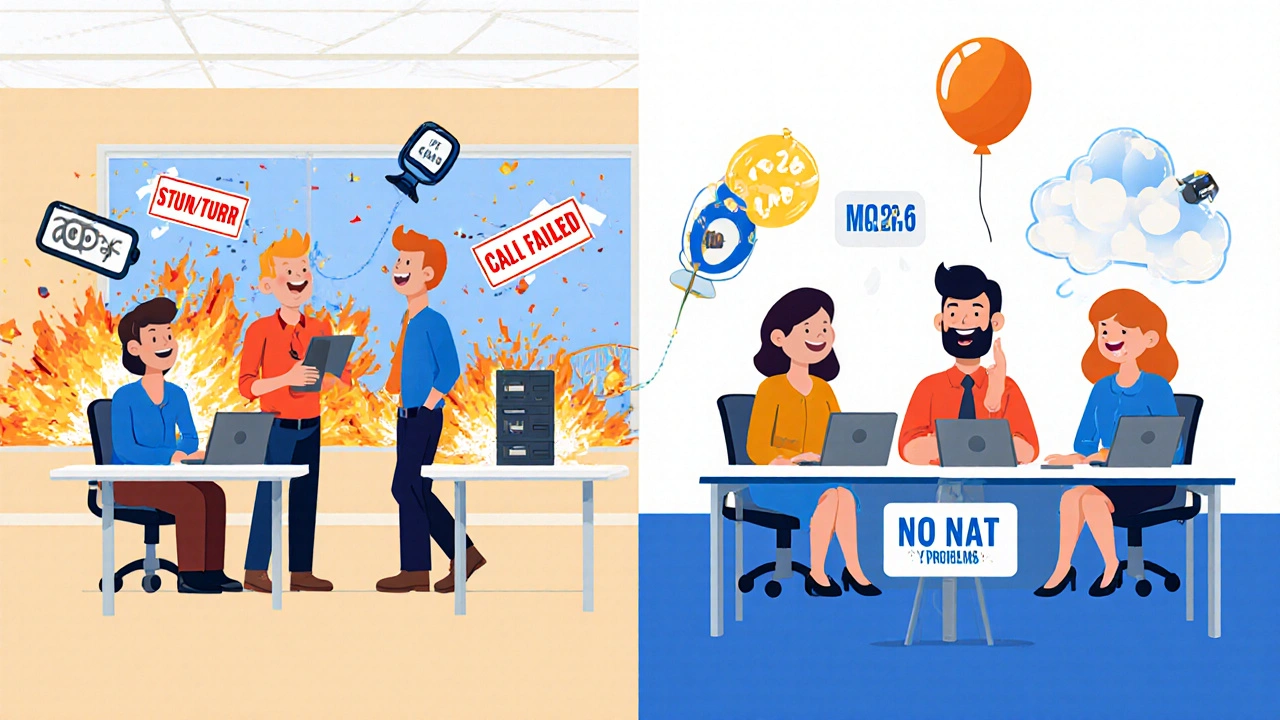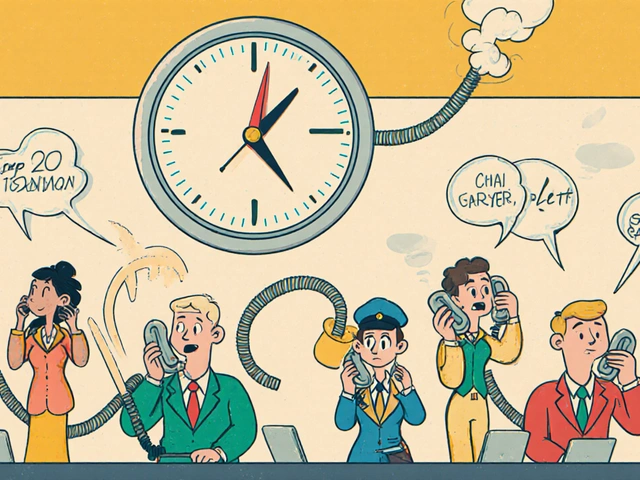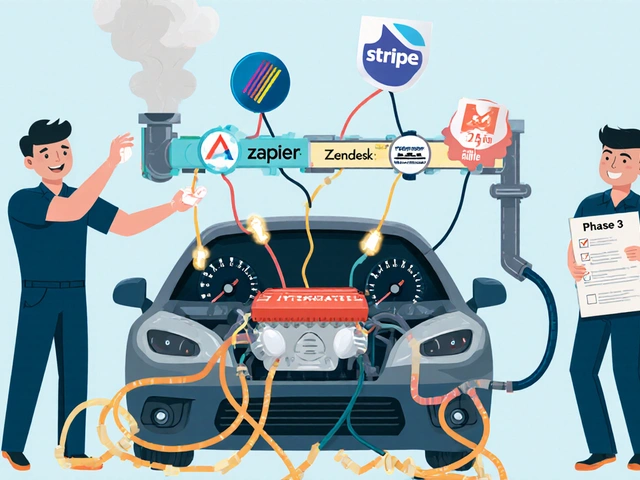When you make a VoIP call, you expect it to connect quickly, sound clear, and stay stable. But if your network still runs on IPv4, you might be fighting hidden problems that IPv6 solves automatically. The difference isn’t just about more addresses-it’s about how calls actually work from start to finish.
Why Addressing Matters More Than You Think
IPv4 uses 32-bit addresses, like 192.0.2.1. That gives you about 4.3 billion possible addresses. Sounds like a lot-until you realize every smartphone, security camera, smart thermostat, and VoIP phone needs one. In 2025, we’ve run out. That’s why most home and business networks use NAT (Network Address Translation) to squeeze hundreds of devices behind a single public IP. But NAT breaks VoIP. VoIP relies on direct connections between endpoints. SIP (Session Initiation Protocol) signals need to find each other. When NAT gets in the way, those signals get lost or blocked. The result? Calls drop, echo creeps in, or the phone just won’t register. Enterprise networks with hundreds of phones see SIP registration failures as high as 18% on IPv4 networks. IPv6 fixes this with 128-bit addresses-340 undecillion unique numbers. That’s enough to give every grain of sand on Earth its own IP. No more NAT. Every VoIP phone gets its own public, routable address. Calls connect directly. No middlemen. No translation layers. No hidden firewalls blocking SIP traffic.NAT: The Silent Killer of VoIP Quality
NAT wasn’t designed for real-time communication. It’s a workaround for a broken system. In VoIP, it causes three big problems:- Call setup delays: Every call must go through a STUN or TURN server to punch through NAT. That adds 200-500ms of extra delay before the call even rings.
- Packet loss: NAT tables timeout. If a call sits idle for a few minutes, the connection breaks. The phone has to re-register, causing dropped calls or dead air.
- Jitter spikes: NAT introduces unpredictable delays. Voice packets arrive unevenly, creating choppy audio. On IPv4, jitter averages 5-15ms. On IPv6, it’s 0.2-0.5ms.
How Call Flow Changes Without NAT
On IPv4, here’s what happens when you dial a number:- Your phone sends a SIP INVITE to your PBX.
- The PBX translates your private IP to a public one using NAT.
- The INVITE goes out to the recipient’s NAT.
- STUN/TURN servers help the recipient’s phone respond.
- The media stream (RTP) tries to find a path back through both NATs.
- Firewalls often block it. You hear silence.
- Your phone sends SIP INVITE directly to the recipient’s public IPv6 address.
- The recipient’s phone receives it immediately-no translation, no servers.
- Media flows directly between endpoints.
- No timeouts. No re-registrations. No dropped calls.

Header Size: The Hidden Cost of IPv6
IPv6 isn’t perfect. Its fixed 40-byte header is bigger than IPv4’s 20-60-byte variable header. For voice packets, that matters. Take G.711, a common uncompressed codec. On IPv4, a voice packet with RTP and UDP headers is about 80 kbps. On IPv6, it jumps to 87.2 kbps. That’s a 9% increase. For G.729, a compressed codec, the jump is 46%-from 8 kbps to 11.7 kbps. That’s because the fixed IPv6 header takes up a bigger chunk of the total packet size. In high-bandwidth offices? No problem. In remote branches with slow internet? That extra 3-4 kbps per call can add up. If you have 50 phones, that’s 150-200 kbps extra traffic. Not a dealbreaker, but something to plan for.QoS: Built-In Priority for Voice
On IPv4, getting good call quality means manually tagging packets with DSCP values. You have to configure routers to treat SIP and RTP traffic as high priority. Miss one setting? Call quality plummets. IPv6 has a built-in solution: the Flow Label field. It’s a 20-bit part of the IPv6 header designed to identify traffic flows. Routers can see “this is voice traffic” without inspecting the payload. No extra configuration. No DSCP rules. Just set it once on your phones, and routers automatically prioritize it. Juniper Networks tested this in 2022. IPv6’s Flow Label reduced per-hop processing latency by 8-12 microseconds. Multiply that across 10 hops? That’s 100+ microseconds saved per call. It’s not loud, but it’s consistent. And in VoIP, consistency is everything.
Real-World Results from Companies That Switched
On Reddit, a network admin named u/VoIP_Guru posted about migrating a Cisco Unified Communications Manager cluster to native IPv6. Before: 12ms jitter. After: 0.8ms. MOS scores jumped from 3.6 to 4.4. No changes to codecs, no new hardware-just IPv6. Microsoft announced in August 2023 that Teams Phone will require IPv6 support for all new deployments starting January 1, 2025. Cisco’s 2023 Voice Technology Report says 78% of enterprises support IPv6-but only 34% have fully switched from dual-stack. Why? Legacy SIP phones. Some older models can’t handle IPv6’s Stateless Address Autoconfiguration (SLAAC). They need firmware updates or replacement. Gartner’s 2023 survey found 92% customer satisfaction with IPv6-capable VoIP systems versus 84% for IPv4-only. The main complaint? Bandwidth use in branch offices. But that’s a solvable problem-optimize codecs, upgrade internet links, or use compression.What You Need to Do Now
You don’t need to rip and replace tomorrow. But you need a plan.- Start with dual-stack: Run IPv4 and IPv6 side by side. Most modern PBXs, SBCs, and phones support it.
- Update your SBC: Session Border Controllers must handle IPv6 signaling and media. Check vendor docs-Cisco and Sonus have solid guides. Avaya’s? Not so much.
- Test your phones: Make sure every endpoint supports IPv6. If it doesn’t, replace it. Poly and Yealink have 93% IPv6-ready models.
- Train your team: Learn Neighbor Discovery Protocol (NDP), SLAAC, and IPv6 security (RA Guard). INE estimates 80-100 hours of training per engineer.
- Plan for bandwidth: Monitor traffic. If you’re using G.729, expect a 46% increase. Upgrade your internet if needed.
The Bottom Line
IPv6 isn’t just the future of VoIP. It’s the only way VoIP works well today. NAT is a band-aid on a broken foundation. IPv6 removes it. The result? Fewer dropped calls, clearer audio, faster setup, and less IT headache. The trade-off? A little more bandwidth. But that’s cheaper than fixing broken calls every week. And as IPv4 addresses hit $50 each by 2026, the cost of clinging to the old system will far exceed the cost of upgrading. Your calls will thank you.Why does IPv6 eliminate NAT problems in VoIP?
IPv6 provides enough unique addresses for every device to have its own public IP. That means VoIP phones can communicate directly with each other without needing NAT to translate private addresses. Without NAT, SIP signaling and media streams (RTP) flow end-to-end without being blocked, delayed, or rewritten-eliminating the root cause of call drops, echo, and registration failures.
Does IPv6 use more bandwidth than IPv4 for VoIP?
Yes, but only slightly. IPv6 has a fixed 40-byte header compared to IPv4’s smaller 20-byte header. For uncompressed codecs like G.711, bandwidth increases by about 9% (80 kbps to 87.2 kbps). For compressed codecs like G.729, it’s a 46% jump-from 8 kbps to 11.7 kbps. This matters most in bandwidth-constrained locations like remote offices. The solution: use efficient codecs and upgrade internet links where needed.
How does IPv6 improve call quality compared to IPv4?
IPv6 improves call quality in three key ways: 1) It cuts jitter from 5-15ms on IPv4 to 0.2-0.5ms on IPv6 by removing NAT-induced delays. 2) It reduces call setup time by 22-35% because there’s no need for STUN/TURN servers. 3) It boosts Mean Opinion Score (MOS) from 3.8 to 4.3, meaning calls sound noticeably clearer and more natural. These improvements come from direct end-to-end connections and built-in traffic prioritization.
Do I need to replace all my VoIP phones to use IPv6?
Not necessarily, but many older models won’t support IPv6. Phones made before 2020 often lack IPv6 firmware. Check your device specs-Poly, Yealink, and Cisco models from 2021 onward typically support IPv6 natively. If your phones don’t, you’ll need firmware updates or replacements. Most vendors now ship 93% of new phones with IPv6 enabled by default.
What’s the easiest way to start moving to IPv6 for VoIP?
Start with dual-stack: enable both IPv4 and IPv6 on your network, PBX, and SBC. Test with one department or branch. Update firmware on phones that need it. Train your IT team on IPv6 addressing and Neighbor Discovery Protocol. Once you’re confident, gradually disable IPv4 on newer devices. Most enterprises use this approach-89% do, according to Nemertes Research.
Is IPv6 more secure than IPv4 for VoIP?
IPv6 has better security potential, but it’s not automatic. Its built-in IPsec support and larger address space make scanning harder. But autoconfiguration features like SLAAC and Router Advertisements (RAs) can be exploited. You must enable RA Guard on your switches and routers to block rogue RAs. Without it, attackers can hijack traffic. Proper configuration makes IPv6 more secure-but misconfigured IPv6 is just as risky as misconfigured IPv4.
When will IPv4 be obsolete for VoIP?
IPv4 won’t disappear overnight, but it’s becoming unsustainable. By 2026, IPv4 addresses will cost over $50 each, making NAT scaling too expensive for medium and large businesses. Microsoft requires IPv6 for all new Teams Phone deployments starting January 2025. The Internet Society predicts 90% of VoIP traffic will use IPv6 by 2030. If you’re building a new system today, you’re already behind if you’re not planning for IPv6.










Write a comment